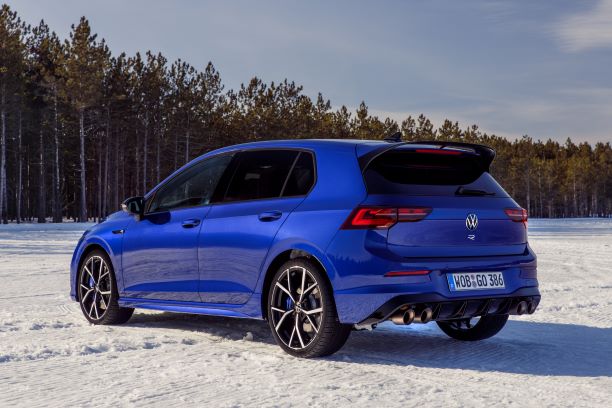SAULT STE. MARIE, MI – Repeatedly plowing through piles of slushy ice with a 2022 Volkswagen Golf R might not be the safest way to treat a car, but it is a way to intimately feel how things work. As a bonus, it can be fun as all get-out.
Which is why it was a recent cold but enjoyable day at the Smithers Winter Test Center in Michigan’s Upper Peninsula, where we were able to drive a German-spec Golf R on various snowy and icy surfaces as an initial introduction to the model’s new Drift mode.
Drift mode is one way VW is giving people a reason to choose the Mk8 ’22 Golf R over the standard Mk8 GTI when both arrive in the U.S. later this year.
The 2.0L turbocharged TSI 4-cyl. and drive-by-wire throttle will be familiar to recent Golf owners, but there are a number of mechanical updates to the new Golf.
The general shape of the new Golf R hasn’t changed, but the ’22 version has visual identifiers to alert those in the know. The front end receives the greatest number of updates, including a new R-specific bumper design and a refreshed grille.
There are mirror caps in matte chrome, and thin, 19-in. Estoril wheels come standard so it’s easy to see the blue brake calipers adorned with the R logo behind them. The Golf R comes with R-specific door sill extensions, bumpers and a gloss black diffuser.
There’s also a two-piece rear spoiler for increased downforce on the rear axle, and the body has been lowered by 0.8 in. (20 mm) compared to the previous Golf R.
The aerodynamic changes mean there is a slight increase in drag compared to the Mk7 Golf R, as well as reduced front lift for more direct steering response and reduced rear lift that improves driving stability at high speeds, VW says.

You can distinguish the Golf R’s interior (above) from those of standard Golf models by a number of exclusive features including a heated sport steering wheel with touch-sensitive buttons, brushed stainless steel pedals and footrest and sport seats with Nappa leather surfaces and R-logo contrast stitching.
The button most likely to be used by performance drivers is the “R” on the left side, which instantly turns on “Race” mode, one of a number of driving modes offered on the new Golf R, as well as electronic stability control (ESC) Sport. From there the driver can select either of the new “Special” and “Drift” modes, which are sub-programs of Race mode.
These modes are possible because of important changes VW made to the powertrain, highlighted by 4Motion all-wheel drive with torque splitter and torque vectoring. Using a torque splitter provides the best possible compromise between function, packaging difficulties and cost, the automaker says.
This application of 4Motion AWD translates into more agility, stability and performance – and, in turn, increased steering precision and driving pleasure on all surfaces.
But it’s the way former Top Gear USA host and rally driver Tanner Foust explains how torque vectoring works that sticks with us the most. Foust is on hand during our Golf R test drive and says when you’re steering and accelerating at the same time, they cancel each other out. Acceleration takes weight off the front tires, which means steering is less effective but adjusting steering means additional friction, which makes acceleration suffer.
AWD will send up to 50% of engine torque to the rear axle. But once there, torque vectoring lets you “paddle on one side of the canoe,” so the system distributes the rear-wheel driving force between the outer and inner wheels at anywhere between zero and 100% during cornering.
Turns out, slippery surfaces are an ideal place to put a new torque-vectoring system to the test, which brings us back to slushy piles of ice.
Even in a slushy mess, the new Golf R’s capability is apparent when driving in Drift mode versus Comfort mode with the new Golf R’s standard ESC turned on (Golf R also allows you to turn off ESC).
It doesn’t take long to realize the Golf R will grip when you want it to and slide like the devil when that’s called for, which is not everywhere. VW has made it so you have to confirm to the system that you’re not driving on public roads to engage drift mode.
VW has proof that its engineering efforts worked, and not just on ice. Wearing Michelin Pilot Sport Cup 2 tires, VW times the Mk7 Golf R lapping the Nordschleife at Nürburgring in 8:10, while the Mk8 Golf R did it in 7:51.
“If you have torque vectoring, you can accelerate much earlier and still maintain steering. That gets you on the throttle so much earlier out of the corner, and you gain miles per hour on the straightaway,” Foust says. “Nineteen seconds on a 20-mile course is a pretty big difference.”
VW isn’t ready to talk about pricing for the new Golf R, but the price tag will be “an acceptably small upcharge” from the outgoing model, considering the amount of technology and innovation that was added to the ’22 version, says Megan Closset, Golf R product manager at Volkswagen of America.
Golf R gets infusion of pep from torque vectoring.





